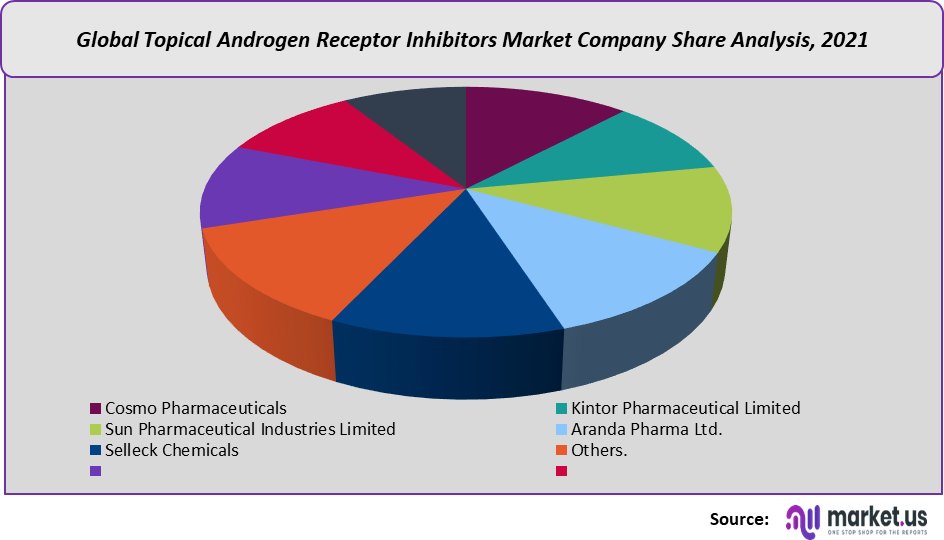Table of Contents
Overview
New York, NY – Aug 21, 2025 – The Global Topical Androgen Receptor Inhibitors Market is projected to reach a valuation of USD 1,65,085.36Mn by 2032 at a CAGR of 15.50%, from USD 39,074.08Mn in 2022.
The development of topical androgen receptor (AR) inhibitors marks a significant advancement in dermatological therapeutics, offering localized and effective treatment options for conditions driven by androgen activity. Unlike systemic therapies, which may present broad side effects, topical AR inhibitors act directly at the site of application, thereby minimizing systemic exposure and enhancing patient safety.
Androgen receptors play a critical role in the pathophysiology of several skin-related disorders, including acne, androgenetic alopecia, and hirsutism. By selectively blocking receptor activity at the skin level, topical formulations address the root cause while preserving systemic hormonal balance. This innovative approach has gained momentum due to the rising demand for safe, convenient, and patient-friendly treatment alternatives.
Several promising candidates are currently in clinical development, with early data demonstrating favorable efficacy and safety profiles. The formulation technologies employed are designed to optimize skin penetration, ensure targeted delivery, and maintain therapeutic concentration in affected tissues. Such advances underscore the growing importance of precision medicine within dermatology.
The market potential for topical AR inhibitors is expected to expand substantially over the next decade, driven by increasing prevalence of dermatological disorders, patient preference for non-invasive solutions, and ongoing innovation by pharmaceutical companies. As research progresses, topical AR inhibitors are anticipated to redefine therapeutic standards, offering patients effective outcomes with improved tolerability.
 Market Segments
Market Segments
Based on Indication:
• Acne
• Alopecia
Based on Distribution Channel:
• Hospital Pharmacies
• Retail Pharmacies
• Drug Stores
• Online Pharmacies
Take advantage of our unbeatable offer - buy now!

Market Regions:
• North America
• Europe
• Asia-Pacific
• South America
• Middle East & Africa
Emerging Trends
- Shift Toward Dermatology Applications: Topical androgen receptor inhibitors are increasingly studied for dermatological diseases such as acne vulgaris, androgenetic alopecia, and hirsutism. Unlike systemic therapies, topical formulations enable localized action, lowering the risks of systemic hormonal disruptions. This trend highlights the demand for safer, patient-friendly solutions addressing chronic, androgen-driven skin and hair conditions.
- Non-Steroidal Molecule Development: The development of novel non-steroidal topical inhibitors is accelerating, driven by the need to minimize systemic absorption and associated risks. These molecules target androgen receptors without steroid-related side effects, offering improved safety and tolerability. Such innovations reflect a broader shift toward precision dermatological therapies emphasizing long-term use, stability, and localized efficacy.
- Combination Therapy Approaches: Combination regimens with topical ARIs are being explored to improve treatment outcomes. Pairing ARIs with minoxidil for alopecia or retinoids and antibiotics for acne may offer synergistic effects. This integrated therapeutic strategy addresses multiple pathogenic pathways simultaneously, improving efficacy, reducing relapse rates, and providing dermatologists with more comprehensive treatment options.
- Focus on Targeted Delivery Systems: Advanced nanocarrier technologies, such as liposomes and nanoparticles, are revolutionizing topical ARI delivery. These systems enhance drug stability, penetration through skin layers, and sustained release at target sites. Such innovations optimize efficacy while reducing systemic exposure, highlighting the growing role of drug delivery science in dermatology and androgen-related disorder treatment.
- Expansion Beyond Dermatology: Research is extending the use of topical ARIs beyond traditional dermatology. Investigations are underway for conditions like seborrheic dermatitis, hidradenitis suppurativa, and androgen receptor–driven cutaneous cancers. This reflects the therapeutic versatility of ARIs and their potential to transform localized care in multiple specialties, broadening market opportunities and clinical relevance significantly.
Use Cases
- Acne Vulgaris Management: Topical ARIs are emerging as promising alternatives for acne treatment by reducing sebaceous gland activity and localized inflammation. Unlike oral anti-androgens, topical options minimize systemic exposure, improving patient safety. They may become vital for individuals requiring long-term acne control with fewer side effects and greater treatment adherence in dermatology.
- Androgenetic Alopecia (Hair Loss): In androgenetic alopecia, topical ARIs target scalp androgen receptors to prevent follicle miniaturization. This localized approach offers a safer, long-term solution compared to systemic therapies, avoiding endocrine disruption. When used alone or in combination with minoxidil, topical ARIs hold strong promise for managing progressive hair loss in men and women.
- Female Hirsutism: Topical ARIs provide localized action to reduce unwanted hair growth in women with hirsutism. By blocking androgen receptors in hair follicles, they present a non-invasive alternative to systemic drugs. This approach may improve cosmetic outcomes, reduce side effects, and support individualized care, particularly for women seeking targeted treatment solutions.
- Seborrhea and Seborrheic Dermatitis: These conditions are strongly linked to excess sebum production driven by androgens. Topical ARIs can inhibit sebaceous gland activity directly at the site, offering targeted therapy. This provides new opportunities to improve patient outcomes where conventional antifungal or anti-inflammatory treatments fail, highlighting a novel path in seborrheic disorder management.
- Adjunct in Prostate Cancer Dermatological Manifestations: Though niche, topical ARIs may serve in oncology supportive care, especially for skin conditions related to androgen-driven processes in prostate cancer. Localized application may help manage dermatological symptoms without systemic burden. This represents a novel adjunctive approach, integrating dermatology and oncology to address patient quality-of-life in cancer therapy.
Conclusion
The development of topical androgen receptor inhibitors represents a transformative advancement in dermatology, offering targeted, safe, and effective alternatives to systemic therapies. By directly modulating androgen activity at the skin level, these formulations address root causes of conditions like acne, alopecia, and hirsutism while minimizing systemic risks.
Ongoing innovation in non-steroidal molecules, delivery technologies, and combination therapies further strengthens their therapeutic promise. With rising prevalence of dermatological disorders and increasing patient preference for non-invasive treatments, the market outlook is highly favorable. Topical AR inhibitors are poised to redefine treatment standards, expand clinical applications, and significantly improve patient outcomes worldwide.
Discuss your needs with our analyst
Please share your requirements with more details so our analyst can check if they can solve your problem(s)



